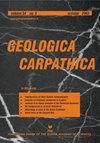Meccek山脉(匈牙利)Toarcian(早侏罗世)菊石动物群的年代地层概述
IF 1.5
4区 地球科学
Q4 GEOSCIENCES, MULTIDISCIPLINARY
引用次数: 1
摘要
世界上许多地方都发现了丰富的早侏罗世氨类动物,它们的多样性历史增强了我们对全球事件及其地理分布的认识,有助于古地理和古海洋学的重建。然而,由于一些领域受到的关注明显较少,研究的强度仍然存在重大差异,但它们的研究将改善区域和全球的相关性和重建。Mecsek山(匈牙利西南部)的Toarcian动物群代表了这样一个知识空白,本文根据het本文章由计算机程序翻译,如有差异,请以英文原文为准。
Chronostratigraphic overview of the Toarcian (Early Jurassic) ammonite fauna from the Mecsek Mountains (Hungary)
: Many localities worldwide yielded rich Toarcian (Early Jurassic) ammonoid faunas whose diversity history enhanced our understanding of global events and their geographic distribution aided paleogeographic and paleoceano-graphic reconstructions. However, major differences remain in the intensity of studies as some areas have received significantly less attention, yet their study would improve regional and global correlations and reconstructions. The Toarcian faunas of the Mecsek Mts (SW Hungary) represented one such knowledge gap that is filled herein on the basis of the large Hetényi Collection and other material, totaling more than 5000 specimens. The Toarcian Ammonitina assemblages are outlined, documenting the occurrence of 43 species, of which 14 stratigraphically important species are described systematically. The studied assemblages bear a close affinity to the NW European faunal province, hence the standard ammonite chronostratigraphic scale is conveniently applicable for subdividing the Toarcian sequence of the Mecsek Mts. All of the Toarcian zones and most subzones are documented by their index taxa and the ranges established from NW European localities allow chronostratigraphic assignment of the ammonite-bearing localities in the Mecsek Mts. A comparison with other coeval faunas from the widespread spotted marl facies reveals that taxon richness here is comparable with that recorded from other parts of the Tisza Mega-Unit in the Apuşeni Mts and the Eastern Carpathians in Romania. Temporal patterns of diversity changes, with peaks in the Bifrons and Thouarsense zones, may be interpreted in the framework of biotic changes in the aftermath of the Jenkyns Event.
求助全文
通过发布文献求助,成功后即可免费获取论文全文。
去求助
来源期刊

Geologica Carpathica
地学-地球科学综合
CiteScore
2.40
自引率
23.10%
发文量
26
审稿时长
>12 weeks
期刊介绍:
GEOLOGICA CARPATHICA covers a wide spectrum of geological disciplines including geodynamics, tectonics and structural geology, volcanology, stratigraphy, geochronology and isotopic geology, karstology, geochemistry, mineralogy, petrology, lithology and sedimentology, paleogeography, paleoecology, paleobiology and paleontology, paleomagnetism, magnetostratigraphy and other branches of applied geophysics, economic and environmental geology, experimental and theoretical geoscientific studies. Geologica Carpathica , with its 60 year old tradition, presents high-quality research papers devoted to all aspects not only of the Alpine-Carpathian-Balkanian geoscience but also with adjacent regions originated from the Mediterranean Tethys and its continental foreland. Geologica Carpathica is an Official Journal of the Carpathian-Balkan Geological Association.
 求助内容:
求助内容: 应助结果提醒方式:
应助结果提醒方式:


